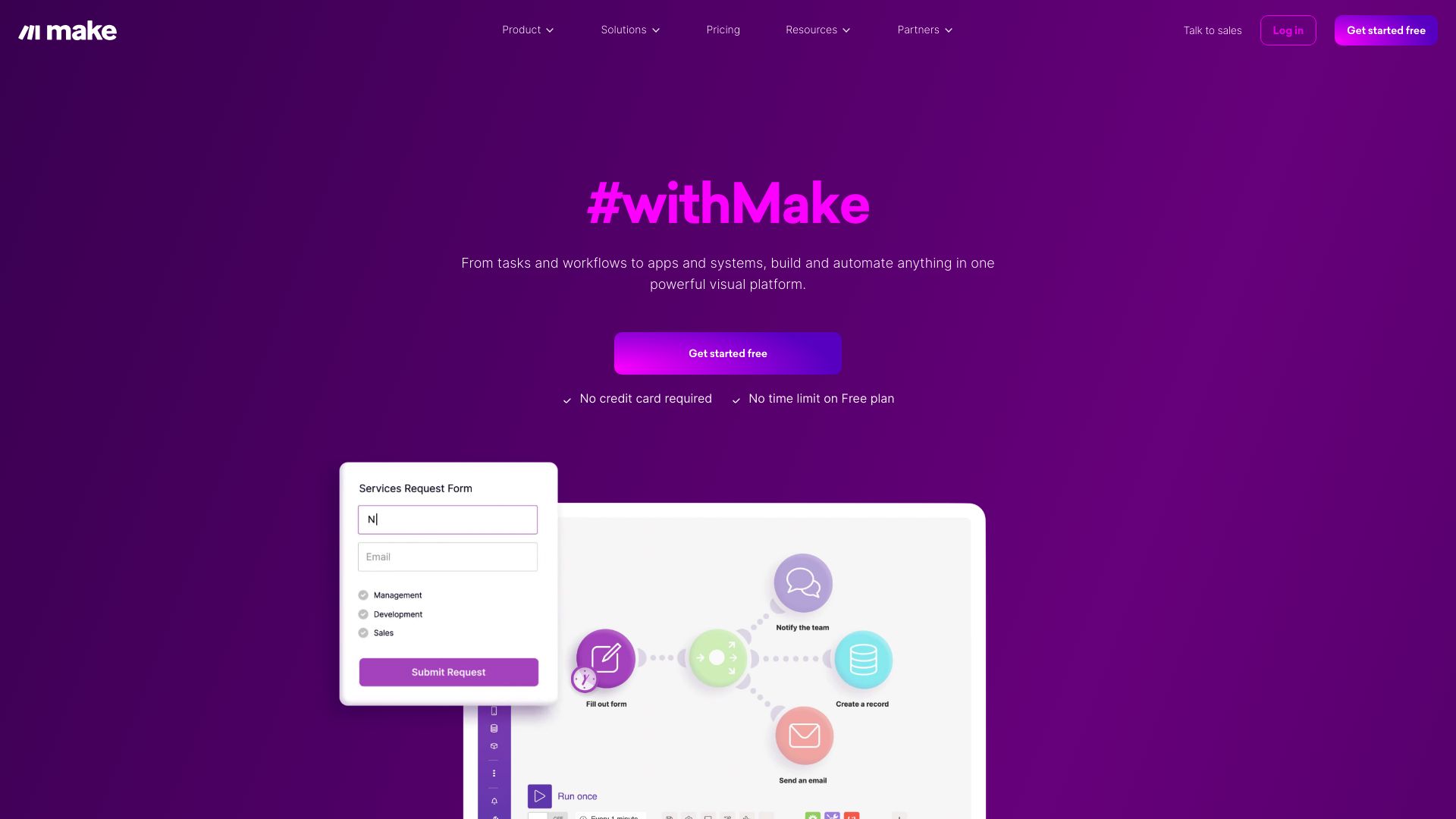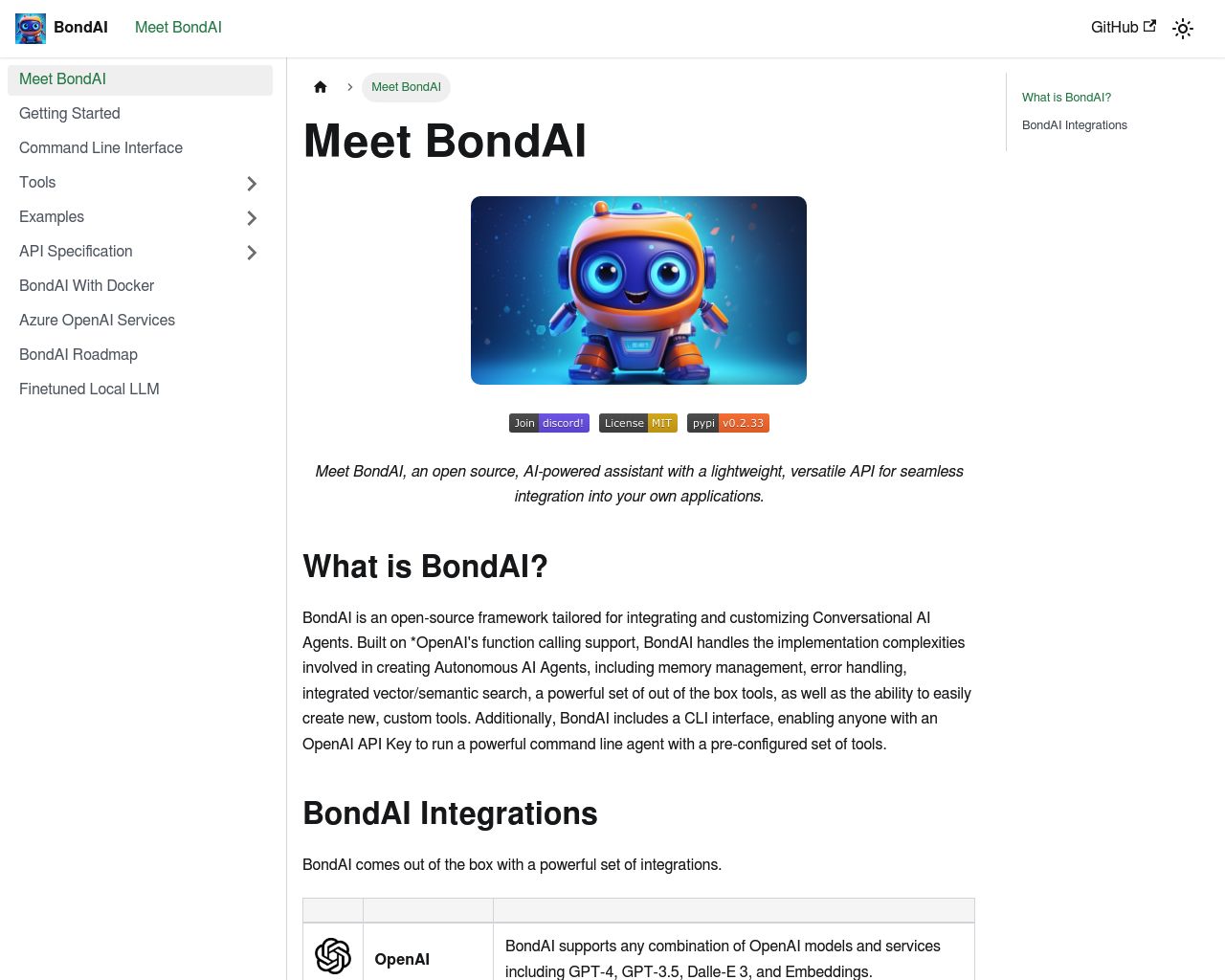Make.com vs. BondAI: Comparing AI-Powered Automation Platforms
AI-powered automation transforms businesses, but choosing the right platform can be daunting. This comparison of Make.com vs. BondAI, and SmythOS reveals how each tackles workflow automation and AI development. Make.com shines with its no-code visual builder and extensive integrations, while BondAI offers advanced AI agent creation for developers.
SmythOS emerges as the standout, combining user-friendly automation with cutting-edge AI capabilities. We’ll explore each platform’s strengths, limitations, and ideal use cases, empowering you to select the best tool for your organization’s needs. Whether you’re a non-technical user seeking efficiency or a developer pushing AI boundaries, this guide illuminates the path to harnessing AI’s full potential in your workflows.
Make.com Overview
Make.com empowers users to create powerful automated workflows without coding. The platform’s visual builder allows drag-and-drop construction of complex integrations between over 1000 apps and services.
Make.com excels at connecting disparate systems and automating repetitive tasks. Marketing teams use it to synchronize customer data across platforms. IT departments leverage Make.com to streamline provisioning workflows. Support teams build automated ticket routing and response systems. The intuitive interface makes these capabilities accessible to both technical and non-technical users.
Make.com empowers users to create powerful automated workflows without coding. The platform’s visual builder allows drag-and-drop construction of complex integrations between over 1000 apps and services.


Make.com’s strength lies in its extensive library of pre-built connectors and its flexible logic tools. Users can transform data, apply conditional branching, and incorporate custom code snippets. This allows for sophisticated automations tailored to specific business needs. The platform also provides robust scheduling options and detailed execution logs for monitoring and troubleshooting.
While Make.com offers powerful automation capabilities, it lacks some advanced AI features found in other platforms. There’s no built-in support for natural language processing or machine learning models. Users focused on developing conversational AI agents or autonomous decision-making systems may find the platform’s capabilities limiting in those areas.
Make.com positions itself as a versatile solution for businesses of all sizes. Its tiered pricing model scales from free personal use to enterprise-level deployments. This flexibility, combined with its no-code approach, makes Make.com an attractive option for organizations looking to rapidly implement workflow automations across departments.
BondAI Overview
BondAI empowers developers to build advanced AI agent systems with its open-source framework. The platform simplifies complex tasks like memory management, error handling, and semantic search, making AI development more accessible.


BondAI supports cutting-edge AI architectures, including ReAct Agents and ConversationalAgents. These technologies enable the creation of sophisticated single-agent models and multi-agent systems capable of tackling complex problems through collaboration.
BondAI supports cutting-edge AI architectures… These technologies enable the creation of sophisticated single-agent models and multi-agent systems capable of tackling complex problems through collaboration.
The framework integrates seamlessly with popular services like OpenAI, Microsoft Azure, and Google Search. It also connects with tools for stock trading, database queries, and phone call handling. This extensive integration network makes BondAI versatile for applications ranging from research to customer support.
BondAI’s standout feature is its advanced memory management system. Inspired by MemGPT research, it uses a tiered approach with core, conversation, and archival memory. This structure allows AI agents to efficiently manage information and enhance their problem-solving abilities.
BondAI’s standout feature is its advanced memory management system… This structure allows AI agents to efficiently manage information and enhance their problem-solving abilities.
Users can deploy BondAI through a Command Line Interface, Docker containers, or direct code integration. This flexibility caters to different development needs and expertise levels. While BondAI offers powerful capabilities, it may require more technical knowledge compared to some no-code platforms, potentially presenting a steeper learning curve for non-developers.
Feature Comparison
Make.com and BondAI offer contrasting approaches to AI and automation, with significant feature gaps in core components and security. Make.com excels in visual workflow building and integrations, while BondAI focuses on advanced AI agent development.
Make.com provides a robust no-code visual builder, enabling users to create complex automated workflows without programming. It offers extensive integration capabilities with over 1000 apps and services. However, Make.com lacks advanced AI features like autonomous agents, memory management, and multimodal capabilities. Its security features include data encryption and OAuth support, but it doesn’t offer constrained alignment or IP control.
BondAI, on the other hand, specializes in AI agent development with sophisticated features like advanced memory management and support for cutting-edge AI architectures. It enables the creation of autonomous agents and multi-agent systems. BondAI offers more advanced problem-solving capabilities and supports human-AI interaction. However, it lacks the visual builder and no-code options that Make.com provides, potentially presenting a steeper learning curve for non-technical users.
In terms of security, BondAI offers more comprehensive features, including constrained alignment to ensure ethical AI behavior. Make.com’s security focuses more on data protection and access control. Both platforms have gaps in certain areas, with Make.com lacking some advanced AI capabilities and BondAI missing some of the user-friendly features for workflow automation.
Feature Comparison Table
| Make.com | BondAI | SmythOS | |
|---|---|---|---|
| CORE FEATURES | |||
| AI Agents | ❌ | ✅ | ✅ |
| Hosted Agents (Dev, Production) | ❌ | ✅ | ✅ |
| Environments (Dev, Production) | ❌ | ✅ | ✅ |
| Visual Builder | ✅ | ❌ | ✅ |
| No-Code Options | ✅ | ❌ | ✅ |
| Memory & Context | ❌ | ✅ | ✅ |
| Autonomous Agents | ❌ | ✅ | ✅ |
| Explainability & Transparency | ❌ | ✅ | ✅ |
| Multimodal | ❌ | ✅ | ✅ |
| Problem-Solving Capabilities | ❌ | ✅ | ✅ |
| Multi-Agent Collaboration | ❌ | ✅ | ✅ |
| Human-AI Interaction | ❌ | ✅ | ✅ |
| Audit Logs for Analytics | ✅ | ❌ | ✅ |
| SECURITY | |||
| Constrained Alignment | ❌ | ❌ | ✅ |
| Data Encryption | ❌ | ✅ | ✅ |
| IP Control | ❌ | ❌ | ✅ |
| COMPONENTS | |||
| Foundation AIs | ❌ | ✅ | ✅ |
| Huggingface AIs | ❌ | ✅ | ✅ |
| Zapier APIs | ❌ | ✅ | ✅ |
| Classifiers | ❌ | ✅ | ✅ |
| Data Lakes | ❌ | ❌ | ✅ |
| DEPLOYMENT OPTIONS (EMBODIMENTS) | |||
| Deploy as API | ❌ | ✅ | ✅ |
| Staging Domains | ❌ | ❌ | ✅ |
| Production Domains | ❌ | ✅ | ✅ |
| Deploy as Site Chat | ❌ | ✅ | ✅ |
| Deploy as Scheduled Agent | ✅ | ❌ | ✅ |
| DATA LAKE SUPPORT | |||
| Hosted Vector Database | ❌ | ❌ | ✅ |
| Sitemap Crawler | ❌ | ❌ | ✅ |
| YouTube Transcript Crawler | ❌ | ❌ | ✅ |
| URL Crawler | ❌ | ✅ | ✅ |
| PDF Support | ❌ | ✅ | ✅ |
| Word File Support | ❌ | ✅ | ✅ |
| TXT File Support | ❌ | ✅ | ✅ |
Best Alternative to Make.com and BondAI
SmythOS emerges as the superior alternative to Make.com and BondAI, offering a comprehensive platform for AI agent development and deployment. Our solution combines the best of both worlds: the intuitive visual building capabilities of Make.com and the advanced AI features of BondAI, while surpassing both in overall functionality and ease of use.
We provide a user-friendly drag-and-drop interface that allows users to create sophisticated AI workflows without extensive coding knowledge. This approach democratizes AI development, making it accessible to a broader audience while still offering the depth and flexibility needed by experienced developers.
SmythOS emerges as the superior alternative to Make.com and BondAI, offering a comprehensive platform for AI agent development and deployment.
Unlike Make.com, which lacks advanced AI capabilities, and BondAI, which may present a steeper learning curve, SmythOS strikes an optimal balance. Our platform supports autonomous agents, advanced memory management, and multimodal interactions, enabling the creation of highly capable AI systems. We also offer extensive integration options, connecting seamlessly with various data sources, APIs, and AI models from providers like OpenAI, Anthropic, and Hugging Face.
Security is a top priority for SmythOS. We implement robust features such as constrained alignment, data encryption, and IP control, addressing the gaps in both Make.com and BondAI’s security offerings. This ensures that AI agents developed on our platform operate ethically and securely, a critical consideration for businesses of all sizes.
With SmythOS, users benefit from unparalleled flexibility in deployment options. Whether you need to deploy your AI agents as APIs, website chatbots, or scheduled tasks, our platform supports it all. This versatility, combined with our scalable infrastructure, makes SmythOS the ideal choice for businesses looking to implement AI solutions that can grow with their needs.
Conclusion
Make.com and BondAI offer distinct approaches to automation and AI development, each with unique strengths. Make.com excels in no-code workflow automation, providing an intuitive visual builder and extensive app integrations. This platform suits business users seeking to streamline processes without deep technical expertise. BondAI, on the other hand, caters to developers with its open-source framework for building sophisticated AI agents, featuring advanced memory management and support for cutting-edge AI architectures.
While both platforms have their merits, SmythOS emerges as the superior choice, combining the best of both worlds. We offer a user-friendly visual builder like Make.com, but with the advanced AI capabilities of BondAI. Our platform supports multimodal interactions, autonomous agents, and multi-agent collaboration, all without requiring coding skills. This makes SmythOS accessible to both technical and non-technical users, bridging the gap between ease of use and powerful AI functionality.
SmythOS stands out with its comprehensive feature set, including hosted agents, debug mode, and extensive deployment options. We provide robust security measures, including constrained alignment and data encryption, addressing enterprise-level concerns. Our platform’s scalability and integration capabilities, with support for over 300,000 integrations, make it adaptable to diverse business needs and workflows.
To experience the transformative power of SmythOS for yourself, explore our diverse range of AI-powered agent templates. These templates cover multiple business categories and offer a quick start to revolutionizing your workflow. For those ready to dive in, create a free SmythOS account and start building AI agents with no time limit or risk. Unlock the full potential of AI for your business and join the forefront of the AI revolution with SmythOS.
Last updated:
Disclaimer: The information presented in this article is for general informational purposes only and is provided as is. While we strive to keep the content up-to-date and accurate, we make no representations or warranties of any kind, express or implied, about the completeness, accuracy, reliability, suitability, or availability of the information contained in this article.
Any reliance you place on such information is strictly at your own risk. We reserve the right to make additions, deletions, or modifications to the contents of this article at any time without prior notice.
In no event will we be liable for any loss or damage including without limitation, indirect or consequential loss or damage, or any loss or damage whatsoever arising from loss of data, profits, or any other loss not specified herein arising out of, or in connection with, the use of this article.
Despite our best efforts, this article may contain oversights, errors, or omissions. If you notice any inaccuracies or have concerns about the content, please report them through our content feedback form. Your input helps us maintain the quality and reliability of our information.
